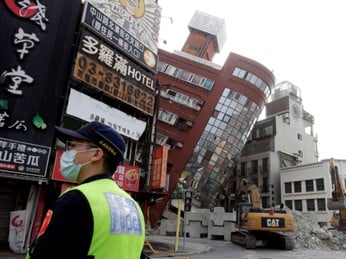M7.4 Taiwan
Status: Closed
| Type of posting | Posting date(EST): | Summary | Downloads |
|---|---|---|---|
| Final Update | 4/5/2024 11:00:00 AM |
|
|
| Similar Stochastic Events | 4/3/2024 2:00:00 PM |
|
|
Final Update | Summary
Posting Date: April 5, 2024, 11:00:00 AM
The death toll has risen to 10 from Wednesday’s magnitude 7.4 earthquake south of Hualien City, Taiwan. More than 100 aftershocks followed the initial quake, the largest of which was measured at M6.5. The initial temblor was the largest to strike Taiwan since 1999, when the “Chi-Chi” earthquake struck Nantou County, killing 2,400 people and destroying thousands of buildings.
ALERT™ subscribers can download an updated and final set of similar stochastic event (SSE) IDs for the recent M7.4 earthquake in Taiwan from the Downloads tab of this posting on the ALERT website. Compatible with Touchstone® and Touchstone Re™, the SSEs were selected based on the event’s location, magnitude, and depth. They should only be used with exposures in Taiwan.
Despite the earthquake’s significant magnitude, there are several contributing factors that may limit the level of insured loss. First, the immediate area around the epicenter is not generally densely populated. Hualien County is home to about 340,000 residents, about 30% of which live in Hualien City. While shaking was reported elsewhere in Taiwan and even in part of neighboring China, reports of major damage have not emerged from those areas, and only minor damage reports have come from Taipei, the nation’s capital and largest city.
Another contributing factor is the enforcement of and recent updates to the building codes in Taiwan. At the time of the Chi-Chi earthquake, vulnerable unreinforced masonry or adobe constructions were common in rural areas. Although they constituted a low percentage of available housing, these structures were associated with a high number of casualties from the earthquake. In urban areas, a substantial percentage of residential units were 12- to 15-story apartments, which typically were cast-in-place reinforced concrete frames with unreinforced masonry infill.
Although most mid-rise buildings performed well during the Chi-Chi earthquake, more than two dozen modern apartment buildings collapsed. Most of these buildings were 5- to 10-years old and designed in accordance with the outdated 1982 Taiwan Building Code. The main cause for the collapse of these structures was the loss of stability on the first floor, which was influenced by the “Open Space” policy initiated by the government in 1984. This policy was intended to allow the owners of buildings located in congested cities to build vertically, as long as the street-level story was open to the public. This policy led to buildings with tall first stories and a discontinuity between the interior and exterior first floor walls, which resulted in an unfavorable soft-story construction. Additionally, collapse was also due to noncompliance with the building codes; for example, many structures lacked critical ductile detailing, such as 135-degree seismic hooks, non-staggered splicing, and poor-quality concrete. The high level of ground motion from this event also exacerbated the situation and contributed to some building collapse.

A partially collapsed commercial building next to an undamaged one in Hualien City (Associated Press)
In December 1999, major updates were made to the seismic building codes, to help guide reconstruction, and another major update arrived in 2005 to include performance-based engineering on certain types of structures. With these updates, as well as other civil defense and preparedness measures, Taiwan has become one of the most prepared nations for earthquakes in the world. Reports following this event seem to back this up; while several dramatic photos showed large commercial buildings in partial collapse in Hualien City, the buildings right next to these damaged structures remained unharmed. This “binary” damage signature has been observed in other recent Taiwan events and was considered by Verisk engineers in evaluating the impacts from this event.
One final contributing factor to lower insured losses is the relatively low insurance take up for the earthquake peril in Taiwan. Real estate firm H&B Realty estimate perhaps only a third of homeowners nationwide have coverage for earthquake damage, and this is lower in some regions, including Hualien County, given in some parts of Taiwan (Taoyuan and Hsinchu) earthquake insurance coverage is mandatory for securing a mortgage. The economic losses from this event could well be significantly larger than the final insured loss tally as a result. Current expectations are that insured losses will have some impact on local insurers but are unlikely to lead to significant impacts in the global markets.
While the Verisk earthquake modeling teams are continuing to study this event, this is the final planned ALERT posting for this event at this time. Please contact your Verisk representative with any additional questions about this event.
Final Update | Downloads
Posting Date: April 5, 2024, 11:00:00 AM
The information provided herein is strictly confidential and is solely for the use of Verisk clients; disclosure to others is prohibited.
Similar Stochastic Event IDs
Note: These lists give event IDs taken from our stochastic catalog that have similar characteristics as the April 3rd earthquake in Taiwan.